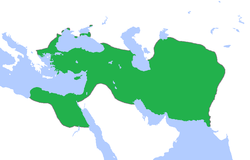Achaemenid Empire
The "Scots" that wis uised in this airticle wis written bi a body that haesna a guid grip on the leid. Please mak this airticle mair better gin ye can. (Januar 2021) |
The Achaemenid Empire, cried the First Persie Empire[10] an aw, wis an empire based in Wastren Asie, foondit bi Cyrus the Great, notable for embracin various ceevilisations an acomin the lairgest empire o the auncient history, spannin at its maximum extent frae the Balkans an Eastren Europe proper in the wast, tae the Indus Valley in the east. It wis lairger nor ony previous empire in history, spannin 5.5[11][12] (or 8[13]) million squerr kilometers. Incorporatin various fowks o different oreegins an faiths, it is notable for its successfu model o a centralised, bureaucratic admeenistration (throu satraps unner the Keeng o Keengs), for biggin infrastructur sic as road systems an a postal seestem, the uise o an offeecial leid athort its territories, an the development o ceevil services an a lairge perfaisional airmy. The empire's successes inspired seemilar seestems in later empires.[14]
Bi the 7t century BC, the Persies haed settled in the sooth-wastren portion o the Iranian Plateau in the region o Persis,[15] that cam tae be thair hertland.[16] Frae this region, Cyrus the Great advanced tae defeat the Medes, Lydia, an the Neo-Babylonian Empire, establishin the Achaemenid Empire. Alexander the Great, an avid admirer o Cyrus the Great,[17] conquered maist o the empire bi 330 BC.[18] Upon Alexander's daiath, maist o the empire's umwhile territory cam unner the rule o the Ptolemaic Kinrick an Seleucid Empire, in addeetion tae ither minor territories that gained unthirldom at that time. The Iranian elites o the central plateau reclaimed pouer bi the seicont century BC unner the Parthian Empire.[16]
The Achaemenid Empire is notit in Western history as the antagonist o the Greek ceety-states in the Greco-Persie Wars an for the emancipation o the Jewish exiles in Babylon. The historical merk o the empire went far ayont its territorial an militar influences an includit cultural, social, technological an releegious influences as weel. Despite the lastin conflict atween the twa states, mony Athenians adoptit Achaemenid customs in their daily leeves in a reciprocal cultural exchynge,[19] some bein employed bi or allied tae the Persie kings. The impact o Cyrus's edict is mentioned in Judeo-Christian texts, an the empire wis instrumental in the spread o Zoroastrianism as far east as Cheenae. The empire set the tone for the politics, heritage an history o Iran (forby official-like kent as Persie) an aw.[20]
References
[eedit | eedit soorce]- ↑ Yarshater, Ehsan (1993). The Cambridge History of Iran, Volume 3. Cambridge University Press. p. 482. ISBN 978-0-521-20092-9.
Of the four residences of the Achaemenids named by Herodotus — Ecbatana, Pasargadae or Persepolis, Susa and Babylon — the last [situated in Iraq] was maintained as their most important capital, the fixed winter quarters, the central office of bureaucracy, exchanged only in the heat of summer for some cool spot in the highlands. Under the Seleucids and the Parthians the site of the Mesopotamian capital moved a little to the north on the Tigris — to Seleucia and Ctesiphon. It is indeed symbolic that these new foundations were built from the bricks of ancient Babylon, just as later Baghdad, a little further upstream, was built out of the ruins of the Sassanian double city of Seleucia-Ctesiphon.
- ↑ Harald Kittel, Juliane House, Brigitte Schultze; Juliane House; Brigitte Schultze (2007). Traduction: encyclopédie internationale de la recherche sur la traduction. Walter de Gruyter. pp. 1194–5. ISBN 978-3-11-017145-7.CS1 maint: multiple names: authors leet (link)
- ↑ Greek and Iranian, E. Tucker, A History of Ancient Greek: From the Beginnings to Late Antiquity, ed. Anastasios-Phoivos Christidēs, Maria Arapopoulou, Maria Chritē, (Cambridge University Press, 2001), 780.
- ↑ Boiy, T. (2004). Late Achaemenid and Hellenistic Babylon. Peeters Publishers. p. 101. ISBN 978-90-429-1449-0.
- ↑ Yarshater (1996, p. 47)
- ↑ Security and Territoriality in the Persian Gulf: A Maritime Political Geography by Pirouz Mojtahed-Zadeh, page 119
- ↑ a b http://www.livius.org/maa-mam/maka/maka.html
- ↑ a b Behistun Inscription
- ↑ Josef Wiesehöfer, Ancient Persia, (I.B. Tauris Ltd, 2007), 119.
- ↑ Sampson, Gareth C. (2008). The Defeat of Rome: Crassus, Carrhae and the Invasion of the East. Pen & Sword Books Limited. p. 33. ISBN 9781844156764.
Cyrus the Great, founder of the First Persian Empire (c. 550–330 BC).
- ↑ Turchin, Peter; Adams, Jonathan M.; Hall, Thomas D (December 2006). "East-West Orientation of Historical Empires". Journal of World-systems Research. 12 (2): 223. ISSN 1076-156X. Retrieved 12 September 2016.
- ↑ Taagepera, Rein (1979). "Size and Duration of Empires: Growth-Decline Curves, 600 B.C. to 600 A.D". Social Science History. 3 (3/4): 121. doi:10.2307/1170959. JSTOR 1170959.
- ↑ Brzezinski, Zbigniew (2012). Strategic vision : America and the crisis of globalpower (PDF). New York: Basic Books. ISBN 978-0465029556. OCLC 787847809.
- ↑ Schmitt Achaemenid dynasty (i. The clan an dynasty)
- ↑ http://www.utexas.edu/cola/centers/lrc/eieol/opeol-MG-X.html Archived 2016-02-18 at the Wayback Machine Macdonell and Keith, Vedic Index. This is based on the evidence ofan Assirie inscription o 844 BC referrin tae the Persies as Paršu, an the Behistun Inscription o Darius I referrin tae Pārsa as the aurie o the Persies. Radhakumud Mookerji (1988). Chandragupta Maurya and His Times (p. 23). Motilal Banarsidass Publ. ISBN 8120804058.
- ↑ a b David Sacks; Oswyn Murray; Lisa R. Brody; Oswyn Murray; Lisa R. Brody (2005). Encyclopedia of the ancient Greek world. Infobase Publishing. p. 256. ISBN 978-0816057221.
- ↑ Ulrich Wilcken (1967). Alexander the Great. W.W. Norton & Company. p. 146. ISBN 978-0393003819.
- ↑ Taagepera, Rein (1979). "Size and Duration of Empires: Growth-Decline Curves, 600 B.C. to 600 A.D". Social Science History. 3 (3/4): 123. doi:10.2307/1170959. JSTOR 1170959.
A superimposition of the maps of Achaemenid and Alexander's empires shows a 90% match, except that Alexander's realm never reached the peak size of the Achaemenid realm.
- ↑ Margaret Christina Miller (2004). Athens and Persia in the Fifth Century BC: A Study in Cultural Receptivity. Cambridge University Press. p. 243. ISBN 978-0521607582.
- ↑ Vesta Sarkhosh Curtis; Sarah Stewart (2005). Birth of the Persian Empire. I.B.Tauris. p. 7. ISBN 978-1845110628.
- Pages uisin collapsible list wi both background an text-align in titlestyle
- Achaemenid Empire
- Auncient Persie
- History o Iran
- History o Zoroastrianism
- History o the Middle East
- History o Europe
- History o Asie
- History o Africae
- Auncient Egyp
- Airn Age Asie
- States o Auncient Africae
- Patronymics
- Superpouers
- 6t-century BC establishments in Asie
- 550s BC
- States an territories established in the 6t century BC


